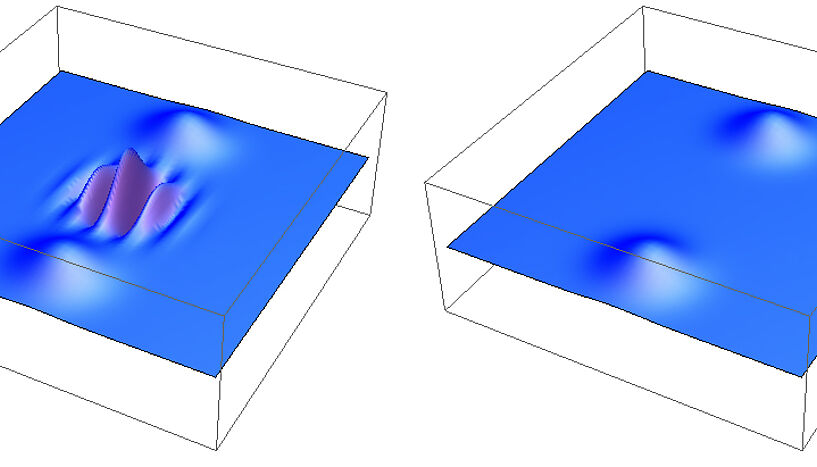Quantum behavior with a flash
16. September 2011
Pulsed quantum optomechanics can directly probe quantum mechanical behavior, which is seen as the central rippling in this representation of a Schrödinger-cat state (left). Under constant observation these quantum features are washed out (right). Image credits: VCQ/University of Vienna.
Just as a camera flash illuminates unseen objects hidden in darkness, a sequence of laser pulses can be used to study the elusive quantum behavior of a large "macroscopic" object. This method provides a novel tool of unprecedented performance for current experiments that push the boundaries of the quantum world to larger and larger scales. A collaboration of scientists led by researchers from the Vienna Center for Quantum Science and Technology (VCQ) at the University of Vienna report this new scheme in the forthcoming issue of PNAS.
One of the most fascinating and still open questions in physics is how far quantum phenomena extend into our everyday world. To answer that, experiments need to peer into the quantum world at a completely new scale of mass and size. This is a bumpy road: it becomes increasingly difficult to detect the genuine quantum features as mass and size are increased.
Overcoming the "blur"
Publishing under the title "Pulsed quantum optomechanics" the research team proposes a method that uses flashes of light to observe quantum features of large objects with unprecedented resolution. The main idea is based on the fact that quantum objects, in contrast to classical objects, behave differently when they are being watched. "In current approaches, objects are constantly monitored and the possible quantum features are being washed out. This is in many ways analogous to the blurring of a photograph of a fast moving object", says Michael R. Vanner, lead author of the paper and member of the Vienna Doctoral School Complex Quantum Systems (CoQuS). "Loosely speaking, the flashes freeze the motion and create a sharp image of the quantum behavior."
How macroscopic can "quantum" be?
With this new tool, experiments will be able to peer into the quantum world at a completely new scale of mass and size. In particular, the scheme can be directly applied to the ongoing experiments that attempt to prepare quantum phenomena in micro-mechanical resonators, i.e. mechanically vibrating massive objects. "By analyzing the dynamics of such behavior, pulsed quantum optomechanics provides a path for investigating whether macroscopic mechanical objects can be used in future quantum technologies. It will also help shed light on nature’s apparent division between the quantum and the classical worlds."
International cooperation
This work has been undertaken as a joint effort by researchers of the Vienna Center for Quantum Science and Technology (VCQ) of the University of Vienna, the Imperial College London, the Institute for Quantum Optics and Quantum Information (IQOQI), the Albert-Einstein Institute of the University of Hannover and the University of Queensland. It was supported by: Australian Research Council, Engineering and Physical Sciences Research Council, European Research Council, European Commission, Foundational Questions Institute, Austrian Science Fund and Austrian Academy of Sciences.
Publication
Pulsed quantum optomechanics. M. R. Vanner, I. Pikovski, G. D. Cole, M. S. Kim, Č. Brukner, K. Hammerer, G. J. Milburn, and M. Aspelmeyer. In: Proceedings of the National Academy of Sciences USA (PNAS). DOI: 10.1073/pnas.1105098108
Links![]() Artikel in PNAS
Artikel in PNAS ![]() Aspelmeyer Group
Aspelmeyer Group![]() Vienna Center for Quantum Science and Technology (VCQ)
Vienna Center for Quantum Science and Technology (VCQ)
Scientific contact
Mag. Michael R. Vanner
Doctoral School Complex Quantum Systems
University of Vienna
T +43-1-4277-725 33
michael.vanner(at)univie.ac.at
Further enquiries
Mag. Alexandra Seiringer
Vienna Center for Quantum Science and Technology (VCQ)
University of Vienna
T +43-1-4277-725 31
vcq(at)quantum.at
aspelmeyer-office(at)univie.ac.at
Wissenschaftlicher Kontakt
Univ.-Prof. Dr. Markus Aspelmeyer
Quantenoptik, Quantennanophysik und QuanteninformationUniversität Wien
1090 - Wien, Boltzmanngasse 5
+43-1-4277-725 31
markus.aspelmeyer@univie.ac.at
Rückfragehinweis
Mag. Alexandra Seiringer
Quantenoptik, Quantennanophysik und QuanteninformationUniversität Wien, Fakultät für Physik
1090 - Wien, Boltzmanngasse 5
+43-1-4277-725 31
aspelmeyer-office@univie.ac.at
Downloads:
CatWigs_01.jpg
Dateigröße: 163,43 KB
